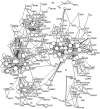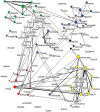Multi-target drugs: the trend of drug research and development
- PMID: 22768266
- PMCID: PMC3386979
- DOI: 10.1371/journal.pone.0040262
Multi-target drugs: the trend of drug research and development
Abstract
Summarizing the status of drugs in the market and examining the trend of drug research and development is important in drug discovery. In this study, we compared the drug targets and the market sales of the new molecular entities approved by the U.S. Food and Drug Administration from January 2000 to December 2009. Two networks, namely, the target-target and drug-drug networks, have been set up using the network analysis tools. The multi-target drugs have much more potential, as shown by the network visualization and the market trends. We discussed the possible reasons and proposed the rational strategies for drug research and development in the future.
Conflict of interest statement
Figures


References
-
- Csermely P, Agoston V, Pongor S. The efficiency of multi-target drugs: the network approach might help drug design. Trends Pharmacol Sci. 2005;26:178–182. - PubMed
-
- Stella GM, Luisetti M, Inghilleri S, Cemmi F, Scabini R, et al. Targeting EGFR in non-small-cell lung cancer: lessons, experiences, strategies. Respir Med. 2012;106:173–183. - PubMed
-
- Petrelli A, Giordano S. From single- to multi-target drugs in cancer therapy: when aspecificity becomes an advantage. Curr Med Chem. 2008;15:422–432. - PubMed
Publication types
MeSH terms
Substances
LinkOut - more resources
Full Text Sources
Other Literature Sources

